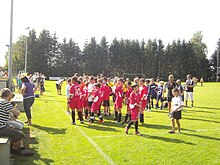D-youth
The D-Jugend (also called D-Juniors) is the fourth oldest group of youth athletes, for example in football or handball .
Classification and regulations
As a rule, the age of these athletes is 11 to 13 years, since they have completed or have completed the 11th or 12th year of life in the calendar year in which the game year begins. In the 2019/20 season, the 2007 and 2008 age groups will take part in the D-Jugend. Depending on their age, the younger athletes belong to the E-youth , F-youth or G-youth , the older ones belong to the C-youth , B-youth or A-youth .
Alternatively, also mostly in the United States, instead of the letter designations, the term U is often used for "under" in connection with the maximum age of the athletes, for example U13 or U12 (corresponds to the D youth). The U-spelling is also common in Austria.
Soccer
For the field of football, the term D-Jugend is defined as follows in accordance with the provisions of the DFB youth regulations:
- §5 youth game regulations
- 1. The football youth plays in age groups. The key date for the age group is January 1st of each year.
- ...
- D-Juniors (U 13 / U 12): D-Juniors in a season are players who are or have reached the age of 11 or 12 in the calendar year in which the game year begins.
Mixed teams (boys and girls) are also allowed in this age group.
Game form
The game form 9 against 9 (also called 8 + 1) is a model that has been recommended by the DFB since the 2011/2012 season and replaces the typical 11 against 11 model in football in many regional associations . Instead of 10 field players, 8 field players and one goalkeeper per team play on a smaller large field. The forms of play may differ in the various regional associations. In the Berlin Football Association , for example, 8 players each play on a small field (half a large field). The small field rules customary in Berlin apply there.
Playtime
Two halves of 30 minutes each are played. The length of the half-time break can be agreed with the referee depending on the division; it usually lasts 5 to 10 minutes.
matchfield
The size of the playing field for 9 against 9 in football is fixed. It is played on a reduced large playing field from penalty area to penalty area. The width of the field is 49 meters. The penalty area is 12 meters deep into the field and 12 meters to the side of the goal. The penalty spot is 9 meters from the goal line. It is played on small field goals (5 × 2 meters) from the E-youth. The lines and corner flags can be marked with flat hats. The large field rules apply.

